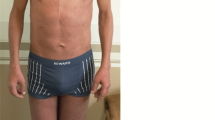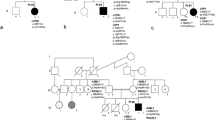Abstract
Noonan syndrome, the most common single-gene cause of congenital heart disease, is characterized by short stature, characteristic facies, learning problems and leukemia predisposition1. Gain-of-function mutations in PTPN11, encoding the tyrosine phosphatase SHP2, cause ∼50% of Noonan syndrome cases. SHP2 is required for RAS-ERK MAP kinase (MAPK) cascade activation2, and Noonan syndrome mutants enhance ERK activation ex vivo3,4 and in mice5. KRAS mutations account for <5% of cases of Noonan syndrome6, but the gene(s) responsible for the remainder are unknown. We identified missense mutations in SOS1, which encodes an essential RAS guanine nucleotide-exchange factor (RAS-GEF), in ∼20% of cases of Noonan syndrome without PTPN11 mutation. The prevalence of specific cardiac defects differs in SOS1 mutation–associated Noonan syndrome. Noonan syndrome–associated SOS1 mutations are hypermorphs encoding products that enhance RAS and ERK activation. Our results identify SOS1 mutants as a major cause of Noonan syndrome, representing the first example of activating GEF mutations associated with human disease and providing new insights into RAS-GEF regulation.
This is a preview of subscription content, access via your institution
Access options
Subscribe to this journal
Receive 12 print issues and online access
$209.00 per year
only $17.42 per issue
Buy this article
- Purchase on Springer Link
- Instant access to full article PDF
Prices may be subject to local taxes which are calculated during checkout



Similar content being viewed by others
References
Tartaglia, M. & Gelb, B.D. Noonan syndrome and related disorders: genetics and pathogenesis. Annu. Rev. Genomics Hum. Genet. 6, 45–68 (2005).
Neel, B.G., Gu, H. & Pao, L. The 'Shp'ing news: SH2 domain-containing tyrosine phosphatases in cell signaling. Trends Biochem. Sci. 28, 284–293 (2003).
Fragale, A., Tartaglia, M., Wu, J. & Gelb, B.D. Noonan syndrome-associated SHP2/PTPN11 mutants cause EGF-dependent prolonged GAB1 binding and sustained ERK2/MAPK1 activation. Hum. Mutat. 23, 267–277 (2004).
Kontaridis, M.I., Swanson, K.D., David, F.S., Barford, D. & Neel, B.G. PTPN11 (SHP2) mutations in LEOPARD syndrome have dominant negative, not activating, effects. J. Biol. Chem. 281, 6785–6792 (2005).
Araki, T. et al. Mouse model of Noonan syndrome reveals cell type- and gene-dosage dependent effects of Ptpn11 mutation. Nat. Med. 10, 849–857 (2004).
Schubbert, S. et al. Germline KRAS mutations cause Noonan syndrome. Nat. Genet. 38, 331–336 (2006).
Bentires-Alj, M., Kontaridis, M.I. & Neel, B.G. Stops on the Ras pathway in human genetic disease. Nat. Med. 12, 283–285 (2006).
Niihori, T. et al. Germline KRAS and BRAF mutations in cardio-facio-cutaneous (CFC) syndrome. Nat. Genet. 38, 294–296 (2006).
Rodriguez-Viciana, P. et al. Germline mutation of genes with the MAPK pathway cause cardio-facio-cutaneous syndrome. Science 311, 1287–1290 (2006).
Sondermann, H., Soisson, S.M., Bar-Sagi, D. & Kuriyan, J. Tandem histone folds in the structure of the N-terminal segment of the Ras activator Son of Sevenless. Structure 11, 1583–1593 (2003).
Sondermann, H., Nagar, B., Bar-Sagi, D. & Kuriyan, J. Computational docking and solution x-ray scattering predict a membrane-interacting role for the histone domain of the Ras activator Son of Sevenless. Proc. Natl. Acad. Sci. USA 102, 16632–16637 (2005).
Nimnual, A. & Bar-Sagi, D. The two hats of SOS. Sci. STKE 2002, PE36 (2002).
Soisson, S.M., Nimnual, A.S., Uy, M., Bar-Sagi, D. & Kuriyan, J. Crystal structure of the Dbl and pleckstrin homology domains from the human Son of Sevenless protein. Cell 95, 259–268 (1998).
Margarit, S.M. et al. Structural evidence for feedback activation by Ras.GTP of the Ras-specific nucleotide exchange factor SOS. Cell 112, 685–695 (2003).
Sondermann, H. et al. Structural analysis of autoinhibition in the Ras activator Son of Sevenless. Cell 119, 393–405 (2004).
Keilhack, H., David, F.S., McGregor, M., Cantley, L.C. & Neel, B.G. Diverse biochemical properties of Shp2 mutants: implications for disease phenotypes. J. Biol. Chem. 280, 30984–30993 (2005).
Goi, T., Rusanescu, G., Urano, T. & Feig, L. Ral-specific guanine nucleotide exchange factor activity opposes other Ras effectors in PC12 cells by inhibiting neurite outgrowth. Mol. Cell. Biol. 19, 1731–1741 (1999).
Hart, T.C. et al. A mutation in the SOS1 gene causes hereditary gingival fibromatosis type 1. Am. J. Hum. Genet. 70, 943–954 (2002).
Bos, J.L. Ras oncogenes in human cancer: A review. Cancer Res. 49, 4682–4689 (1989).
Cichowski, K. et al. Mouse models of tumor development in neurofibromatosis Type 1. Science 286, 2172–2176 (1999).
Lauchle, J.O., Braun, B.S., Loh, M.L. & Shannon, K. Inherited predispositions and hyperactive Ras in myeloid leukemogenesis. Pediatr. Blood Cancer 46, 579–585 (2006).
van der Burgt, I. et al. Clinical and molecular studies in a large Dutch family with Noonan syndrome. Am. J. Med. Genet. 53, 187–191 (1994).
Godbey, W.T., Wu, K.K., Hirasaki, G.J. & Mikos, A.G. Improved packing of poly(ethylenimine)/DNA complexes increases transfection efficiency. Gene Ther. 6, 1380–1388 (1999).
Acknowledgements
We are indebted to the dedicated patients and families with Noonan syndrome who volunteered for this research study, W. Robinson (Noonan Syndrome Support Group) and the referring physicians. This work was supported in part by US National Institutes of Health grants DE16140 (to R.S.K.), R37CA49152 (to B.G.N.) and MO1-RR02172; the National Center for Research Resources, Children's Hospital Boston General Clinical Research Center and the Harvard Partners Center for Genetics and Genomics (A.E.R.). T. A. is a Special Fellow of the Leukemia and Lymphoma Society.
Author information
Authors and Affiliations
Contributions
The study was designed by A.E.R., R.S.K, and B.G.N., patient phenotyping was performed by A.E.R. and T.A.S.; gene sequencing was conducted by K.T.M., V.A.J., L.L., Y.Y. and A.M.T. and structural and biochemical analysis by K.D.S., T.A. and B.G.N.
Corresponding author
Ethics declarations
Competing interests
The authors declare no competing financial interests.
Supplementary information
Supplementary Fig. 1
Noonan syndrome–associated SOS1 mutants cause sustained ERK activation. (PDF 83 kb)
Supplementary Fig. 2
Noonan syndrome–associated SOS1 mutants enhance endogenous ERK activation. (PDF 98 kb)
Supplementary Table 1
Genotype-phenotype correlations in Noonan syndrome (PDF 158 kb)
Supplementary Table 2
Primer pairs used for gene amplification. (PDF 119 kb)
Rights and permissions
About this article
Cite this article
Roberts, A., Araki, T., Swanson, K. et al. Germline gain-of-function mutations in SOS1 cause Noonan syndrome. Nat Genet 39, 70–74 (2007). https://doi.org/10.1038/ng1926
Received:
Accepted:
Published:
Issue Date:
DOI: https://doi.org/10.1038/ng1926
This article is cited by
-
High frequency of hotspot mutation in PTPN11 gene among Moroccan patients with Noonan syndrome
Journal of Applied Genetics (2024)
-
Novel effects of Ras-MAPK pathogenic variants on the developing human brain and their link to gene expression and inhibition abilities
Translational Psychiatry (2023)
-
Cutis verticis gyrata and Noonan syndrome: report of two cases with pathogenetic variant in SOS1 gene
Italian Journal of Pediatrics (2022)
-
MR lymphangiography of lymphatic abnormalities in children and adults with Noonan syndrome
Scientific Reports (2022)
-
Altered canonical and striatal-frontal resting state functional connectivity in children with pathogenic variants in the Ras/mitogen-activated protein kinase pathway
Molecular Psychiatry (2022)



